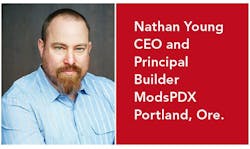Nathan Young sits in the middle of his 60,000-square-foot warehouse in north Portland, Ore., wearing a thick, hooded sweatshirt with the words “Game Changer” across the front. An old-school site-builder and framer by training, he’s been leading (and growing) ModsPDX, an off-site home construction/modular business, since the Great Recession caused him to rethink his approach to legacy building methods.
To be sure, ModsPDX is not a high-tech facility run by robots or similar automation, but it doesn’t need to be. In fact, combining detail-oriented, building-science–based stick framing with a manufacturing mindset and a controlled construction environment is all Young needs to achieve greater efficiencies and lower production costs than his on-site competitors.
It might not be as sexy as some off-site advocates portray, but Young’s measured approach may well be the poster child for changes in housing construction.
Q What got you started in factory-built housing?
A The market crash [of 2008] took us from 12 guys to just me and a significant amount of overhead I was still paying for. I started looking into modular and found it wasn’t much different from stick building, just more controlled. When we moved our framing operations indoors, the principles were to better understand the science of building and how to put our products together more efficiently to build a higher-quality product.
Q How does ModsPDX achieve efficiencies?
A In any kind of building construction, every house is essentially a combination of boxes; it’s just how you put those boxes together [that varies]. If we can standardize the [dimensions of the] box—what I call a universal building platform—I know, for instance, that every one of my floor joists is the same length, and I can “mass produce” them quickly.
We also save a lot of time because, being inside, we can just unplug and leave our tools and hoses where they are at the end of the day and pick them up [to start working] the next morning. On a jobsite, you might spent 45 minutes setting up at the start of the day and another 45 minutes rolling up at the end of the day. That time isn’t lost in here.
Q What other benefits have you realized?
A Our tolerances here are extremely tight. That floor [points to a nearby module] is 78 feet end-to-end and has a 1/8-inch variance over that length. We also don’t have any moisture in our buildings; the wettest our lumber ever gets is when it’s delivered. We’re also always building on the floor of the warehouse; each module for a four-story townhouse or apartment building is on the floor versus up in the air when you’re outside, which is a safer and faster way to build.
Q How has your approach to building changed?
A Our brains have changed from being very linear in how we build to having more of a manufacturing mindset, such as where and how to stage materials and modules or panels for receiving and shipping. We went from focusing on speed, like an on-site framer, to efficiency, like a manufacturer, and looking at the whole system versus just the framing.
Q What role does automation play in your operation?
A We’ve looked a lot at automation, but there’s a high capital cost. By the time we would have programmed the machine to know everything we need it to do, I’d have a house framed. It’s really an issue of scale and downtime. You need a steady volume to continually feed that machine, and the minute you don’t have enough, your ship is going to sink.
Q Is this a model for the future of modular housing?
A For smaller builders, I think something like this is fairly attainable. Basically, we work in a 60,000-square-foot warehouse with overhead cranes and a Gradall forklift and about $50,000 in table saws, shop saws, and nail guns. It [doesn’t cost] multimillion dollars to get into it.
